Large-Scale Network-Based Observations of a Saharan Dust Event across the European Continent in Spring 2022
Abstract
1. Introduction
2. Materials and Methods
2.1. EARLINET Stations
2.2. The Cloud–Aerosol Lidar and Infrared Pathfinder Satellite Observation (CALIPSO) Satellite
2.3. Selection of Dust Aerosol Layers
2.4. Navy Aerosol Analysis and Prediction System (NAAPS)
2.5. Definition of the Regions and HYSPLIT Model
3. Results and Discussion
3.1. Description of the Event
3.2. Aerosol Geometrical and Optical Properties Per Site and Region
3.3. Aerosol Geometrical and Optical Properties as Obtained by CALIPSO
3.4. Case Study (16 March 2022)
4. Conclusions
Author Contributions
Funding
Data Availability Statement
Acknowledgments
Conflicts of Interest
Appendix A
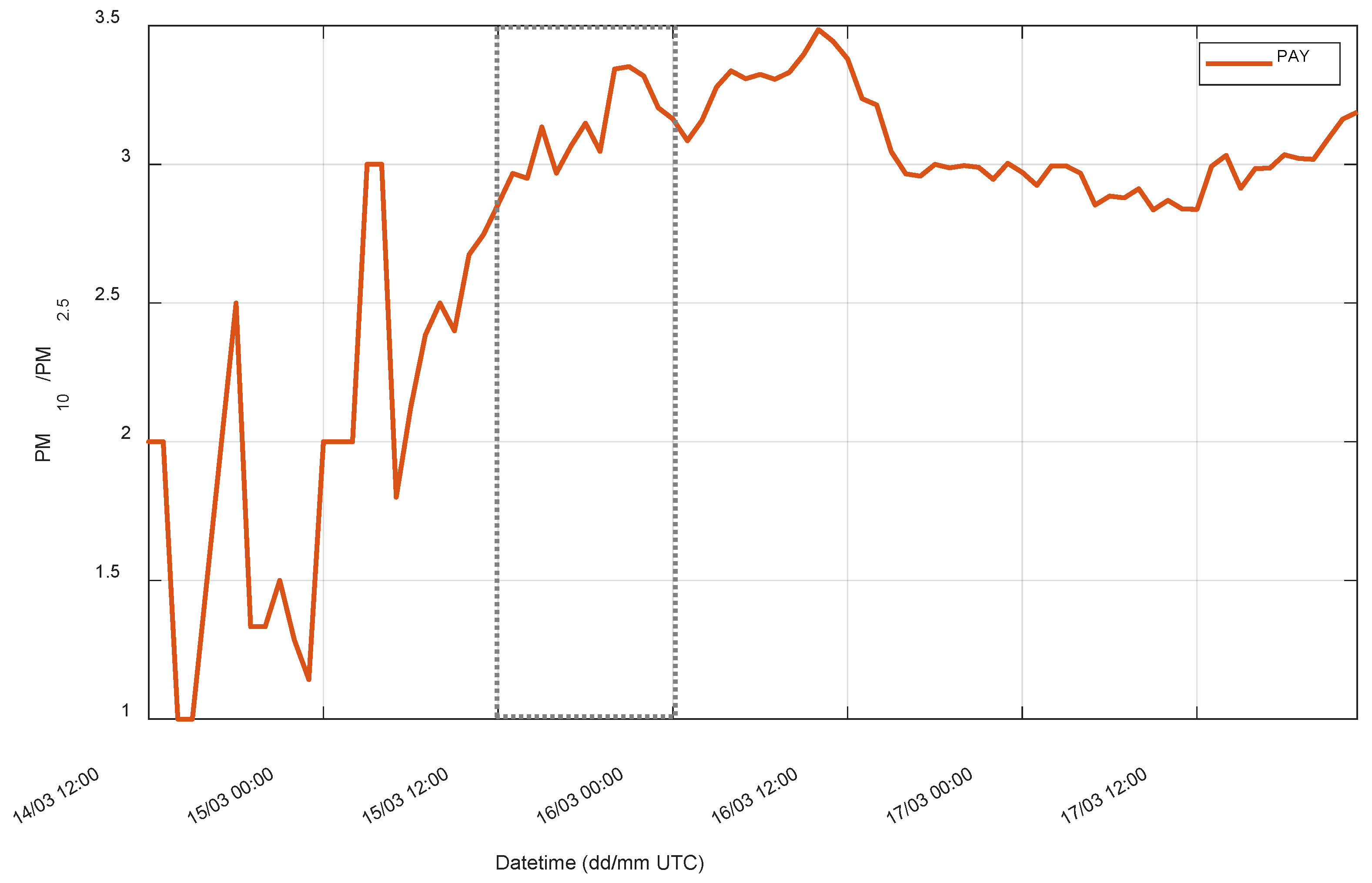
References
- Kok, J.F.; Adebiyi, A.A.; Albani, S.; Balkanski, Y.; Checa-Garcia, R.; Chin, M.; Colarco, P.R.; Hamilton, D.S.; Huang, Y.; Ito, A.; et al. Contribution of the World’s Main Dust Source Regions to the Global Cycle of Desert Dust. Atmos. Chem. Phys. 2021, 21, 8169–8193. [Google Scholar] [CrossRef]
- IPCC. Summary for Policymakers. In Climate Change 2023: Synthesis Report, Contribution of Working Groups I, II and III to the Sixth Assessment Report of the Intergovernmental Panel on Climate Change; Core Writing Team, Lee, H., Romero, J., Eds.; IPCC: Geneva, Switzerland, 2023; pp. 1–34. [Google Scholar] [CrossRef]
- Andreae, M.O.; Rosenfeld, D. Aerosol–cloud–precipitation Interactions. Part 1. The Nature and Sources of Cloud-Active Aerosols. Earth-Sci. Rev. 2008, 89, 13–41. [Google Scholar] [CrossRef]
- Seigel, R.B.; Van Den Heever, S.C.; Saleeby, S.M. Mineral Dust Indirect Effects and Cloud Radiative Feedbacks of a Simulated Idealized Nocturnal Squall Line. Atmos. Chem. Phys. 2013, 13, 4467–4485. [Google Scholar] [CrossRef]
- Rosenfeld, D. Suppression of Rain and Snow by Urban and Industrial Air Pollution. Science 2000, 287, 1793–1796. [Google Scholar] [CrossRef] [PubMed]
- Giannadaki, D.; Pozzer, A.; Lelieveld, J. Modeled Global Effects of Airborne Desert Dust on Air Quality and Premature Mortality. Atmos. Chem. Phys. 2014, 14, 957–968. [Google Scholar] [CrossRef]
- Mylonaki, M.; Gini, M.; Georgopoulou, M.; Pilou, M.; Chalvatzaki, E.; Solomos, S.; Diapouli, E.; Giannakaki, E.; Lazaridis, M.; Pandis, S.N.; et al. Wildfire and African Dust Aerosol Oxidative Potential, Exposure and Dose in the Human Respiratory Tract. Sci. Total Environ. 2024, 913, 169683. [Google Scholar] [CrossRef]
- Goudie, A.S. Desert Dust and Human Health Disorders. Environ. Int. 2014, 63, 101–113. [Google Scholar] [CrossRef]
- Zhang, X.; Zhao, L.; Tong, D.Q.; Wu, G.; Dan, M.; Teng, B. A Systematic Review of Global Desert Dust and Associated Human Health Effects. Atmosphere 2016, 7, 158. [Google Scholar] [CrossRef]
- World Health Organization. WHO Global Air Quality Guidelines. In Particulate Matter (PM2.5 and PM10), Ozone, Nitrogen Dioxide, Sulfur Dioxide and Carbon Monoxide; World Health Organization: Geneva, Switzerland, 2021; pp. 1–360. [Google Scholar]
- Mona, L.; Liu, Z.; Müller, D.; Omar, A.; Papayannis, A.; Pappalardo, G.; Sugimoto, N.; Vaughan, M. Lidar Measurements for Desert Dust Characterization: An Overview. Adv. Meteorol. 2012, 2012, 356265. [Google Scholar] [CrossRef]
- Giannakaki, E.; Balis, D.S.; Amiridis, V.; Zerefos, C. Optical Properties of Different Aerosol Types: Seven Years of Combined Raman-Elastic Backscatter Lidar Measurements in Thessaloniki, Greece. Atmos. Meas. Tech. 2010, 3, 569–578. [Google Scholar] [CrossRef]
- Fernández, A.J.; Sicard, M.; Costa, M.J.; Guerrero-Rascado, J.L.; Gómez-Amo, J.L.; Molero, F.; Barragán, R.; Basart, S.; Bortoli, D.; Bedoya-Velásquez, A.E.; et al. Extreme, Wintertime Saharan Dust Intrusion in the Iberian Peninsula: Lidar Monitoring and Evaluation of Dust Forecast Models during the February 2017 Event. Atmos. Res. 2019, 228, 223–241. [Google Scholar] [CrossRef]
- Mona, L.; Papagiannopoulos, N.; Basart, S.; Baldasano, J.; Binietoglou, I.; Cornacchia, C.; Pappalardo, G. EARLINET Dust Observations vs. BSC-DREAM8b Modeled Profiles: 12-Year-Long Systematic Comparison at Potenza, Italy. Atmos. Chem. Phys. 2014, 14, 8781–8793. [Google Scholar] [CrossRef]
- Cazorla, A.; Andrés Casquero-Vera, J.; Román, R.; Luis Guerrero-Rascado, J.; Toledano, C.; Cachorro, V.E.; Orza, J.A.G.; Cancillo, M.L.; Serrano, A.; Titos, G.; et al. Near-Real-Time Processing of a Ceilometer Network Assisted with Sun-Photometer Data: Monitoring a Dust Outbreak over the Iberian Peninsula. Atmos. Chem. Phys. 2017, 17, 11861–11876. [Google Scholar] [CrossRef]
- Mamouri, R.E.; Ansmann, A.; Nisantzi, A.; Solomos, S.; Kallos, G.; Hadjimitsis, D.G. Extreme Dust Storm over the Eastern Mediterranean in September 2015: Satellite, Lidar, and Surface Observations in the Cyprus Region. Atmos. Chem. Phys. 2016, 16, 13711–13724. [Google Scholar] [CrossRef]
- Nisantzi, A.; Mamouri, R.E.; Ansmann, A.; Hadjimitsis, D. Injection of Mineral Dust into the Free Troposphere during Fire Events Observed with Polarization Lidar at Limassol, Cyprus. Atmos. Chem. Phys. 2014, 14, 12155–12165. [Google Scholar] [CrossRef]
- Guerrero-Rascado, J.L.; Olmo, F.J.; Avilés-Rodríguez, I.; Navas-Guzmán, F.; Pérez-Ramírez, D.; Lyamani, H.; Arboledas, L.A. Extreme Saharan Dust Event over the Southern Iberian Peninsula in September 2007: Active and Passive Remote Sensing from Surface and Satellite. Atmos. Chem. Phys. 2009, 9, 8453–8469. [Google Scholar] [CrossRef]
- Soupiona, O.; Papayannis, A.; Kokkalis, P.; Foskinis, R.; Sánchez Hernández, G.; Ortiz-Amezcua, P.; Mylonaki, M.; Papanikolaou, C.A.; Papagiannopoulos, N.; Samaras, S.; et al. EARLINET Observations of Saharan Dust Intrusions over the Northern Mediterranean Region (2014–2017): Properties and Impact on Radiative Forcing. Atmos. Chem. Phys. 2020, 20, 15147–15166. [Google Scholar] [CrossRef]
- Mylonaki, M.; Papayannis, A.; Papanikolaou, C.-A.; Foskinis, R.; Soupiona, O.; Maroufidis, G.; Anagnou, D.; Kralli, E. Tropospheric Vertical Profiling of the Aerosol Backscatter Coefficient and the Particle Linear Depolarization Ratio for Different Aerosol Mixtures during the PANACEA Campaign in July 2019 at Volos, Greece. Atmos. Environ. 2021, 247, 118184. [Google Scholar] [CrossRef]
- Mylonaki, M.; Giannakaki, E.; Papayannis, A.; Papanikolaou, C.; Komppula, M. Aerosol Type Classification Analysis Using EARLINET Multiwavelength and Depolarization Lidar Observations. Atmos. Chem. Phys. 2021, 21, 2211–2227. [Google Scholar] [CrossRef]
- Papayannis, A.; Amiridis, V.; Mona, L.; Tsaknakis, G.; Balis, D.; Bösenberg, J.; Chaikovski, A.; De Tomasi, F.; Grigorov, I.; Mattis, I.; et al. Systematic Lidar Observations of Saharan Dust over Europe in the Frame of EARLINET (2000–2002). J. Geophys. Res. Atmos. 2008, 113, 148–227. [Google Scholar] [CrossRef]
- Soupiona, O.; Samaras, S.; Ortiz-Amezcua, P.; Böckmann, C.; Papayannis, A.; Moreira, G.A.; Benavent-Oltra, J.A.; Guerrero-Rascado, J.L.; Bedoya-Velásquez, A.E.; Olmo, F.J.; et al. Retrieval of Optical and Microphysical Properties of Transported Saharan Dust over Athens and Granada Based on Multi-Wavelength Raman Lidar Measurements: Study of the Mixing Processes. Atmos. Environ. 2019, 214, 116824. [Google Scholar] [CrossRef]
- Soupiona, O.; Papayannis, A.; Kokkalis, P.; Mylonaki, M.; Tsaknakis, G.; Argyrouli, A.; Vratolis, S. Long-Term Systematic Profiling of Dust Aerosol Optical Properties Using the EOLE NTUA Lidar System over Athens, Greece (2000–2016). Atmos. Environ. 2018, 183, 165–174. [Google Scholar] [CrossRef]
- Kokkalis, P.; Soupiona, O.; Papanikolaou, C.A.; Foskinis, R.; Mylonaki, M.; Solomos, S.; Vratolis, S.; Vasilatou, V.; Kralli, E.; Anagnou, D.; et al. Radiative Effect and Mixing Processes of a Long-Lasting Dust Event over Athens, Greece, during the COVID-19 Period. Atmosphere 2021, 12, 318. [Google Scholar] [CrossRef]
- Szczepanik, D.M.; Stachlewska, I.S.; Tetoni, E.; Althausen, D. Properties of Saharan Dust Versus Local Urban Dust—A Case Study. Earth Space Sci. 2021, 8, e2021EA001816. [Google Scholar] [CrossRef]
- López-Cayuela, M.Á.; Córdoba-Jabonero, C.; Bermejo-Pantaleón, D.; Sicard, M.; Salgueiro, V.; Molero, F.; Carvajal-Pérez, C.V.; Granados-Muñoz, M.J.; Comerón, A.; Couto, F.T.; et al. Vertical Characterization of Fine and Coarse Dust Particles during an Intense Saharan Dust Outbreak over the Iberian Peninsula in Springtime 2021. Atmos. Chem. Phys. 2023, 23, 143–161. [Google Scholar] [CrossRef]
- Müller, D.; Heinold, B.; Tesche, M.; Tegen, I.; Althausen, D.; Arboledas, L.A.; Amiridis, V.; Amodeo, A.; Ansmann, A.; Balis, D.; et al. EARLINET Observations of the 14-22-May Long-Range Dust Transport Event during SAMUM 2006: Validation of Results from Dust Transport Modelling. Tellus Ser. B Chem. Phys. Meteorol. 2009, 61, 325–339. [Google Scholar] [CrossRef]
- Hofer, J.; Althausen, D.; Abdullaev, S.F.; Makhmudov, A.N.; Nazarov, B.I.; Schettler, G.; Engelmann, R.; Baars, H.; Fomba, K.W.; Müller, K.; et al. Long-Term Profiling of Mineral Dust and Pollution Aerosol with Multiwavelength Polarization Raman Lidar at the Central Asian Site of Dushanbe, Tajikistan: Case Studies. Atmos. Chem. Phys. 2017, 17, 14559–14577. [Google Scholar] [CrossRef]
- Adebiyi, A.A.; Kok, J.F. Climate Models Miss Most of the Coarse Dust in the Atmosphere. Sci. Adv. 2020, 6, eaaz9507. [Google Scholar] [CrossRef]
- Cuevas-Agulló, E.; Barriopedro, D.; García, R.D.; Alonso-pérez, S. Sharp Increase in Saharan Dust Intrusions over the Western Euro-Mediterranean in February–March 2020–2022 and Associated Atmospheric Circulation. Atmos. Chem. Phys. 2024, 24, 4083–4104. [Google Scholar] [CrossRef]
- Pappalardo, G.; Amodeo, A.; Apituley, A.; Comeron, A.; Freudenthaler, V.; Linné, H.; Ansmann, A.; Bösenberg, J.; D’Amico, G.; Mattis, I.; et al. EARLINET: Towards an Advanced Sustainable European Aerosol Lidar Network. Atmos. Meas. Tech. 2014, 7, 2389–2409. [Google Scholar] [CrossRef]
- Winker, D.M.; Tackett, J.L.; Getzewich, B.J.; Liu, Z.; Vaughan, M.A.; Rogers, R.R. The Global 3-D Distribution of Tropospheric Aerosols as Characterized by CALIOP. Atmos. Chem. Phys. 2013, 13, 3345–3361. [Google Scholar] [CrossRef]
- Winker, D.M.; Vaughan, M.A.; Omar, A.; Hu, Y.; Powell, K.A.; Liu, Z.; Hunt, W.H.; Young, S.A. Overview of the CALIPSO Mission and CALIOP Data Processing Algorithms. J. Atmos. Ocean. Technol. 2009, 26, 2310–2323. [Google Scholar] [CrossRef]
- Kim, M.H.; Omar, A.H.; Tackett, J.L.; Vaughan, M.A.; Winker, D.M.; Trepte, C.R.; Hu, Y.; Liu, Z.; Poole, L.R.; Pitts, M.C.; et al. The CALIPSO Version 4 Automated Aerosol Classification and Lidar Ratio Selection Algorithm. Atmos. Meas. Tech. 2018, 11, 6107–6135. [Google Scholar] [CrossRef] [PubMed]
- Omar, A.H.; Winker, D.M.; Vaughan, M.A.; Hu, Y.; Trepte, C.R.; Ferrare, R.A.; Lee, K.-P.; Hostetler, C.A.; Kittaka, C.; Rogers, R.R.; et al. The CALIPSO Automated Aerosol Classification and Lidar Ratio Selection Algorithm. J. Atmos. Ocean. Technol. 2009, 26, 1994–2014. [Google Scholar] [CrossRef]
- Tackett, J.L.; Kar, J.; Vaughan, M.A.; Getzewich, B.J.; Kim, M.; Omar, A.H.; Magill, B.E.; Pitts, M.C.; Winker, D.M. The CALIPSO Version 4.5 Stratospheric Aerosol Subtyping Algorithm. Atmos. Meas. Tech. 2022, 16, 745–768. [Google Scholar] [CrossRef]
- Stein, A.F.; Draxler, R.R.; Rolph, G.D.; Stunder, B.J.B.; Cohen, M.D.; Ngan, F. NOAA’s Hysplit Atmospheric Transport and Dispersion Modeling System. Bull. Am. Meteorol. Soc. 2015, 96, 2059–2077. [Google Scholar] [CrossRef]
- Rolph, G.; Stein, A.; Stunder, B. Real-Time Environmental Applications and Display SYstem: READY. Environ. Model. Softw. 2017, 95, 210–228. [Google Scholar] [CrossRef]
- Draxler, R.R. 1999: HYSPLIT4 User’s Guide; NOAA Tech. Memo. ERL ARL-230; NOAA Air Resources Laboratory: Silver Spring, MD, USA, 2009. [Google Scholar]
- Draxler, R.R.; Hess, G.D. An Overview of the HYSPLIT_4 Modelling System for Trajectories, Dispersion and Deposition. Aust. Meteorol. Mag. 1998, 47, 295–308. [Google Scholar]
- Papayannis, A.; Mamouri, R.E.; Amiridis, V.; Giannakaki, E.; Veselovskii, I.; Kokkalis, P.; Tsaknakis, G.; Balis, D.; Kristiansen, N.I.; Stohl, A.; et al. Optical Properties and Vertical Extension of Aged Ash Layers over the Eastern Mediterranean as Observed by Raman Lidars during the Eyjafjallajökull Eruption in May 2010. Atmos. Environ. 2012, 48, 56–65. [Google Scholar] [CrossRef]
- Lynch, P.; Reid, J.S.; Westphal, D.L.; Zhang, J.; Hogan, T.F.; Hyer, E.J.; Curtis, C.A.; Hegg, D.A.; Shi, Y.; Campbell, J.R.; et al. An 11-Year Global Gridded Aerosol Optical Thickness Reanalysis (v1.0) for Atmospheric and Climate Sciences. Geosci. Model Dev. 2016, 9, 1489–1522. [Google Scholar] [CrossRef]
- Trickl, T.; Vogelmann, H.; Fromm, M.D.; Jäger, H.; Perfahl, M.; Steinbrecht, W. Measurement Report: Violent Biomass Burning and Volcanic Eruptions—A New Period of Elevated Stratospheric Aerosol over Central Europe (2017 to 2023) in a Long Series of Observations. Atmos. Chem. Phys. 2024, 24, 1997–2021. [Google Scholar] [CrossRef]
- Young, S.A.; Vaughan, M.A.; Garnier, A.; Tackett, J.L.; Lambeth, J.D.; Powell, K.A. Extinction and Optical Depth Retrievals for CALIPSO’s Version 4 Data Release. Atmos. Meas. Tech. 2018, 11, 5701–5727. [Google Scholar] [CrossRef]
- D’Amico, G.; Amodeo, A.; Baars, H.; Binietoglou, I.; Freudenthaler, V.; Mattis, I.; Wandinger, U.; Pappalardo, G. EARLINET Single Calculus Chain–Overview on Methodology and Strategy. Atmos. Meas. Tech. 2015, 8, 4891–4916. [Google Scholar] [CrossRef]
- Mattis, I.; D’Amico, G.; Baars, H.; Amodeo, A.; Madonna, F.; Iarlori, M. EARLINET Single Calculus Chain-Technical—Part 2: Calculation of Optical Products. Atmos. Meas. Tech. 2016, 9, 3009–3029. [Google Scholar] [CrossRef]
- D’Amico, G.; Amodeo, A.; Mattis, I.; Freudenthaler, V.; Pappalardo, G. EARLINET Single Calculus Chain-Technical Andndash; Part 1: Pre-Processing of Raw Lidar Data. Atmos. Meas. Tech. 2016, 9, 491–507. [Google Scholar] [CrossRef]
- Mamouri, R.E.; Ansmann, A.; Nisantzi, A.; Kokkalis, P.; Schwarz, A.; Hadjimitsis, D. Low Arabian Dust Extinction-to-Backscatter Ratio. Geophys. Res. Lett. 2013, 40, 4762–4766. [Google Scholar] [CrossRef]
- Nisantzi, A.; Mamouri, R.E.; Ansmann, A.; Schuster, G.L.; Hadjimitsis, D.G. Middle East versus Saharan Dust Extinction-to-Backscatter Ratios. Atmos. Chem. Phys. 2015, 15, 7071–7084. [Google Scholar] [CrossRef]
- Szczepanik, D.M.; Poczta, P.; Talianu, C.; Böckmann, C.; Ritter, C.; Stefanie, H.; Toanca, F.; Chojnicki, B.H.; Schüttemeyer, D.; Stachlewska, I.S. Spatio-Temporal Evolution of Long-Range Transported Mineral Desert Dust Properties over Rural and Urban Sites in Central Europe. Sci. Total Environ. 2023, 903, 166173. [Google Scholar] [CrossRef]
- Granados-Muñoz, M.J.; Navas-Guzmán, F.; Bravo-Aranda, J.A.; Guerrero-Rascado, J.L.; Lyamani, H.; Valenzuela, A.; Titos, G.; Fernández-Gálvez, J.; Alados-Arboledas, L. Hygroscopic Growth of Atmospheric Aerosol Particles Based on Active Remote Sensing and Radiosounding Measurements: Selected Cases in Southeastern Spain. Atmos. Meas. Tech. 2015, 8, 705–718. [Google Scholar] [CrossRef]
- Pereira, G.; Shimabukuro, Y.E.; Moraes, E.C.; Freitas, S.R.; Cardozo, F.S.; Longo, K.M. Monitoring the Transport of Biomass Burning Emission in South America. Atmos. Pollut. Res. 2011, 2, 247–254. [Google Scholar] [CrossRef]
- Janicka, L.; Stachlewska, I.S.; Veselovskii, I.; Baars, H. Temporal Variations in Optical and Microphysical Properties of Mineral Dust and Biomass Burning Aerosol Derived from Daytime Raman Lidar Observations over Warsaw, Poland. Atmos. Environ. 2017, 169, 162–174. [Google Scholar] [CrossRef]
- Sicard, M.; Barragan, R.; Sanchez, R.Z. Contribution of EARLINET/ACTRIS to the Summer 2013 Special Observing Period of the ChArMEx Project: Monitoring of a Saharan Dust Event over the Western and Central Mediterranean. Int. J. Remote Sens. 2016, 37, 4698–4711. [Google Scholar] [CrossRef]
- Granados-Muñoz, M.J.; Bravo-Aranda, J.A.; Baumgardner, D.; Guerrero-Rascado, J.L.; Pérez-Ramírez, D.; Navas-Guzmán, F.; Veselovskii, I.; Lyamani, H.; Valenzuela, A.; Olmo, F.J.; et al. A Comparative Study of Aerosol Microphysical Properties Retrieved from Ground-Based Remote Sensing and Aircraft in Situ Measurements during a Saharan Dust Event. Atmos. Meas. Tech. 2016, 9, 1113–1133. [Google Scholar] [CrossRef]
- Veselovskii, I.; Goloub, P.; Podvin, T.; Bovchaliuk, V.; Derimian, Y.; Augustin, P.; Fourmentin, M.; Tanre, D.; Korenskiy, M.; Whiteman, D.N.; et al. Retrieval of Optical and Physical Properties of African Dust from Multiwavelength Raman Lidar Measurements during the SHADOW Campaign in Senegal. Atmos. Chem. Phys. 2016, 16, 7013–7028. [Google Scholar] [CrossRef]
- Veselovskii, I.; Hu, Q.; Goloub, P.; Podvin, T.; Korenskiy, M.; Derimian, Y.; Legrand, M.; Castellanos, P. Variability in Lidar-Derived Particle Properties over West Africa Due to Changes in Absorption: Towards an Understanding. Atmos. Chem. Phys. 2020, 20, 6563–6581. [Google Scholar] [CrossRef]
- Tesche, M.; Ansmann, A.; Müller, D.; Althausen, D.; Engelmann, R.; Freudenthaler, V.; Groß, S. Vertically Resolved Separation of Dust and Smoke over Cape Verde Using Multiwavelength Raman and Polarization Lidars during Saharan Mineral Dust Experiment 2008. J. Geophys. Res. Atmos. 2009, 114, 1–14. [Google Scholar] [CrossRef]
- Freudenthaler, V.; Esselborn, M.; Wiegner, M.; Heese, B.; Tesche, M.; Ansmann, A.; Müller, D.; Althausen, D.; Wirth, M.; Fix, A.; et al. Depolarization Ratio Profiling at Several Wavelengths in Pure Saharan Dust during SAMUM 2006. Tellus Ser. B Chem. Phys. Meteorol. 2009, 61, 165–179. [Google Scholar] [CrossRef]
- Groß, S.; Gasteiger, J.; Freudenthaler, V.; Müller, T.; Sauer, D.; Toledano, C.; Ansmann, A. Saharan Dust Contribution to the Caribbean Summertime Boundary Layer—A Lidar Study during SALTRACE. Atmos. Chem. Phys. 2016, 16, 11535–11546. [Google Scholar] [CrossRef]
- Eleftheratos, K.; Kouklaki, D.; Zerefos, C. Sixteen Years of Measurements of Ozone over Athens, Greece with a Brewer Spectrophotometer. Oxygen 2021, 1, 32–45. [Google Scholar] [CrossRef]
- Bauer, S.; Bierwirth, E.; Esselborn, M.; Petzold, A.; Macke, A.; Trautmann, T.; Wendisch, M. Airborne Spectral Radiation Measurements to Derive Solar Radiative Forcing of Saharan Dust Mixed with Biomass Burning Smoke Particles. Tellus Ser. B Chem. Phys. Meteorol. 2011, 63, 742–750. [Google Scholar] [CrossRef][Green Version]
- Ryder, C.L.; McQuaid, J.B.; Flamant, C.; Rosenberg, P.D.; Washington, R.; Brindley, H.E.; Highwood, E.J.; Marsham, J.H.; Parker, D.J.; Todd, M.C.; et al. Advances in Understanding Mineral Dust and Boundary Layer Processes over the Sahara from Fennec Aircraft Observations. Atmos. Chem. Phys. 2015, 15, 8479–8520. [Google Scholar] [CrossRef]
- Maring, H.; Savoie, D.L.; Izaguirre, M.A.; Custals, L.; Reid, J.S. Mineral Dust Aerosol Size Distribution Change during Atmospheric Transport. J. Geophys. Res. Atmos. 2003, 108, 8592. [Google Scholar] [CrossRef]
- Knippertz, P.; Todd, M.C. Mineral Dust Aerosols over the Sahara: Meteorological Controls on Emission and Transport and Implications for Modeling. Rev. Geophys. 2012, 50. [Google Scholar] [CrossRef]
- Haarig, M.; Ansmann, A.; Engelmann, R.; Baars, H.; Toledano, C.; Torres, B.; Althausen, D.; Radenz, M.; Wandinger, U. First Triple-Wavelength Lidar Observations of Depolarization and Extinction-to-Backscatter Ratios of Saharan Dust. Atmos. Chem. Phys. 2022, 22, 355–369. [Google Scholar] [CrossRef]
- Mirzabaev, A.; Wu, J.; Evans, J.; García-Oliva, F.; Hussein, I.A.G.; Iqbal, M.M.; Kimutai, J.; Knowles, T.; Meza, F.; Nedjraoui, D.; et al. Desertification; Cambridge University Press: Cambridge, UK, 2022; ISBN 9781009157988. [Google Scholar]
- Trickl, T.; Jaeger, H. NDACC stratospheric aerosol LIDAR data from the station Garmisch-Partenkirchen. ESA Atmos. Valid. Data Cent. 2023. [Google Scholar] [CrossRef]
- Vogelmann, H.; Trickl, T.; Speidel, J. NDACC stratospheric aerosol LIDAR data from the station Schneefernerhaus on Mt. Zugspitze. ESA Atmos. Valid. Data Cent. 2023. [Google Scholar] [CrossRef]
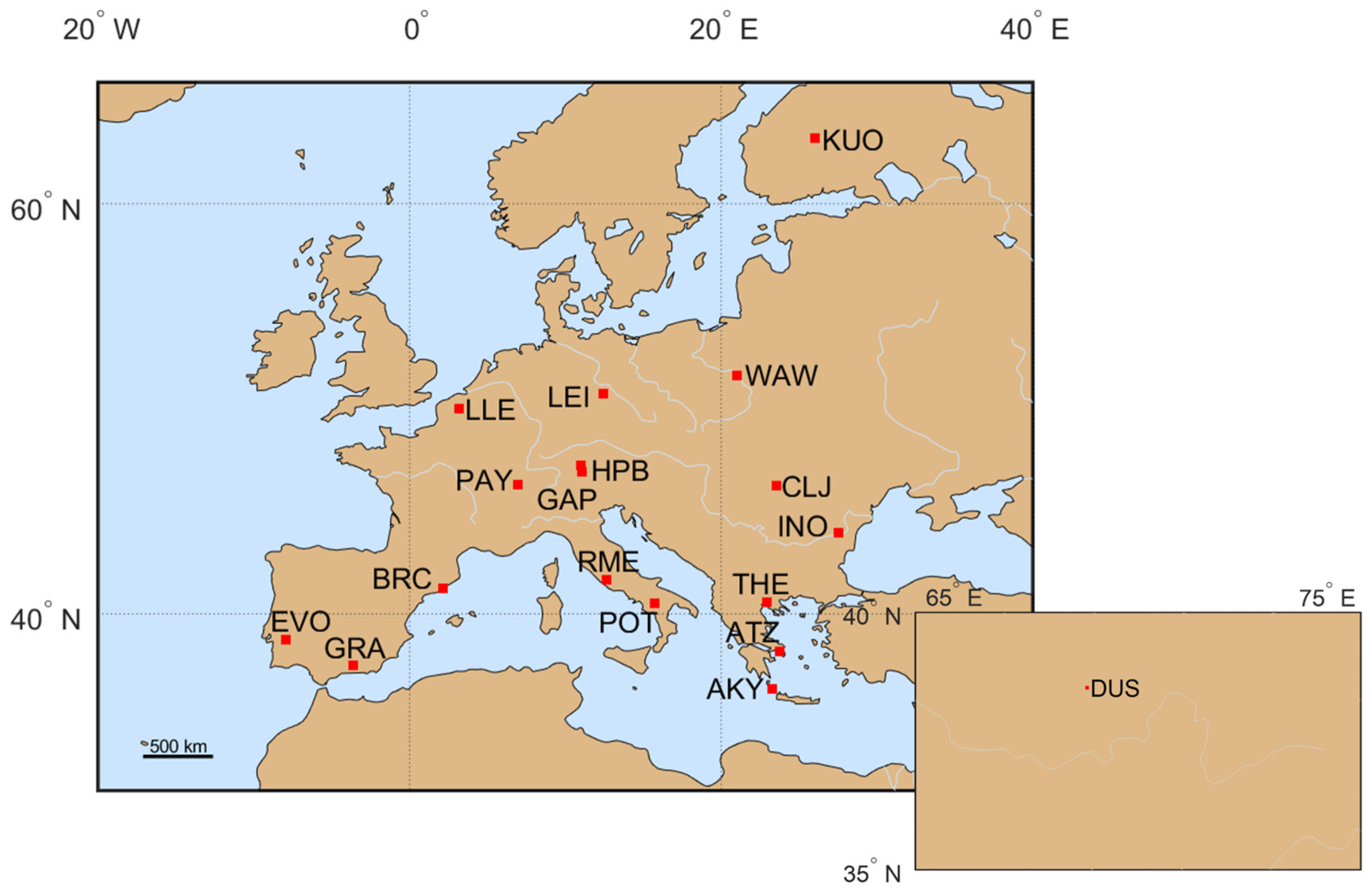


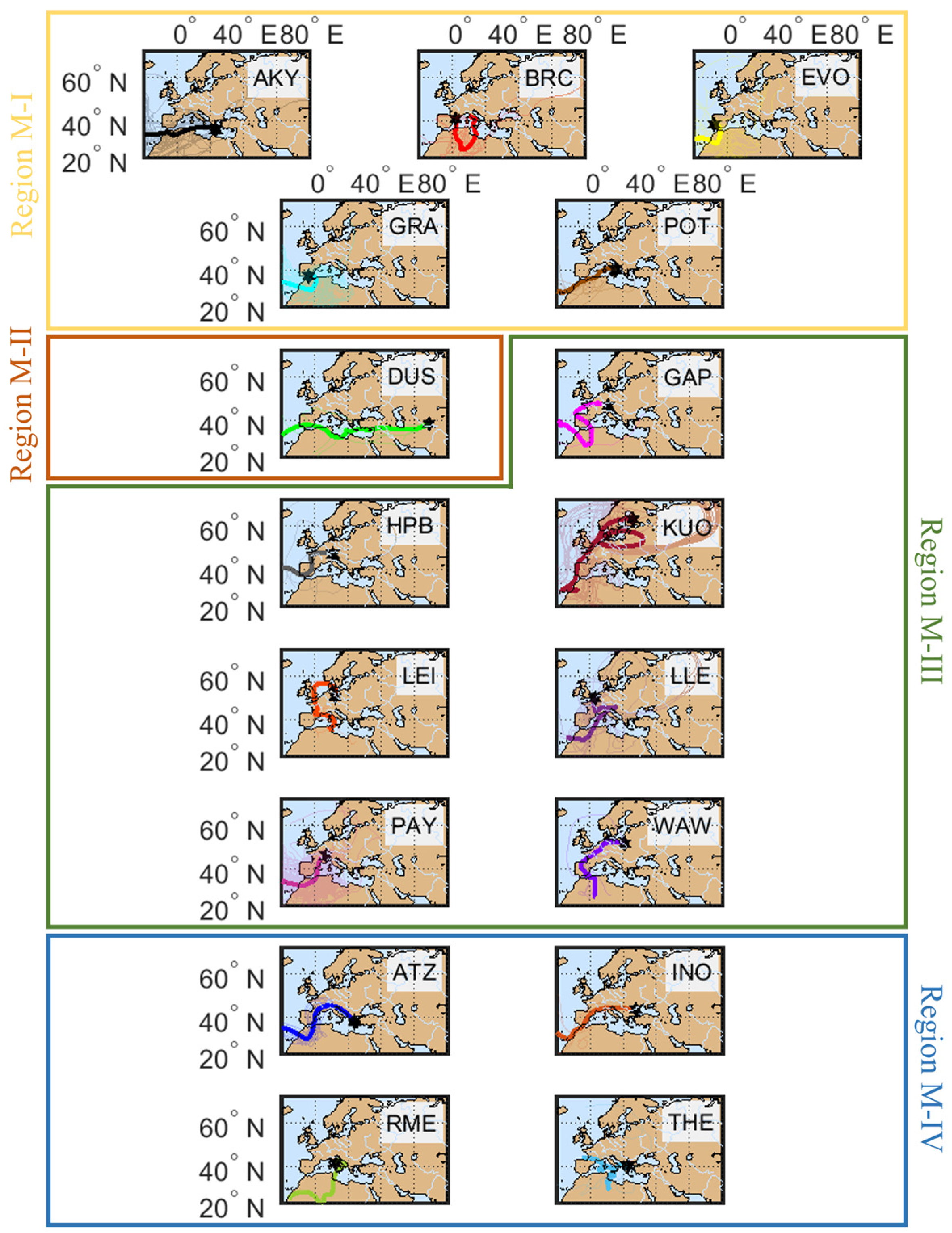

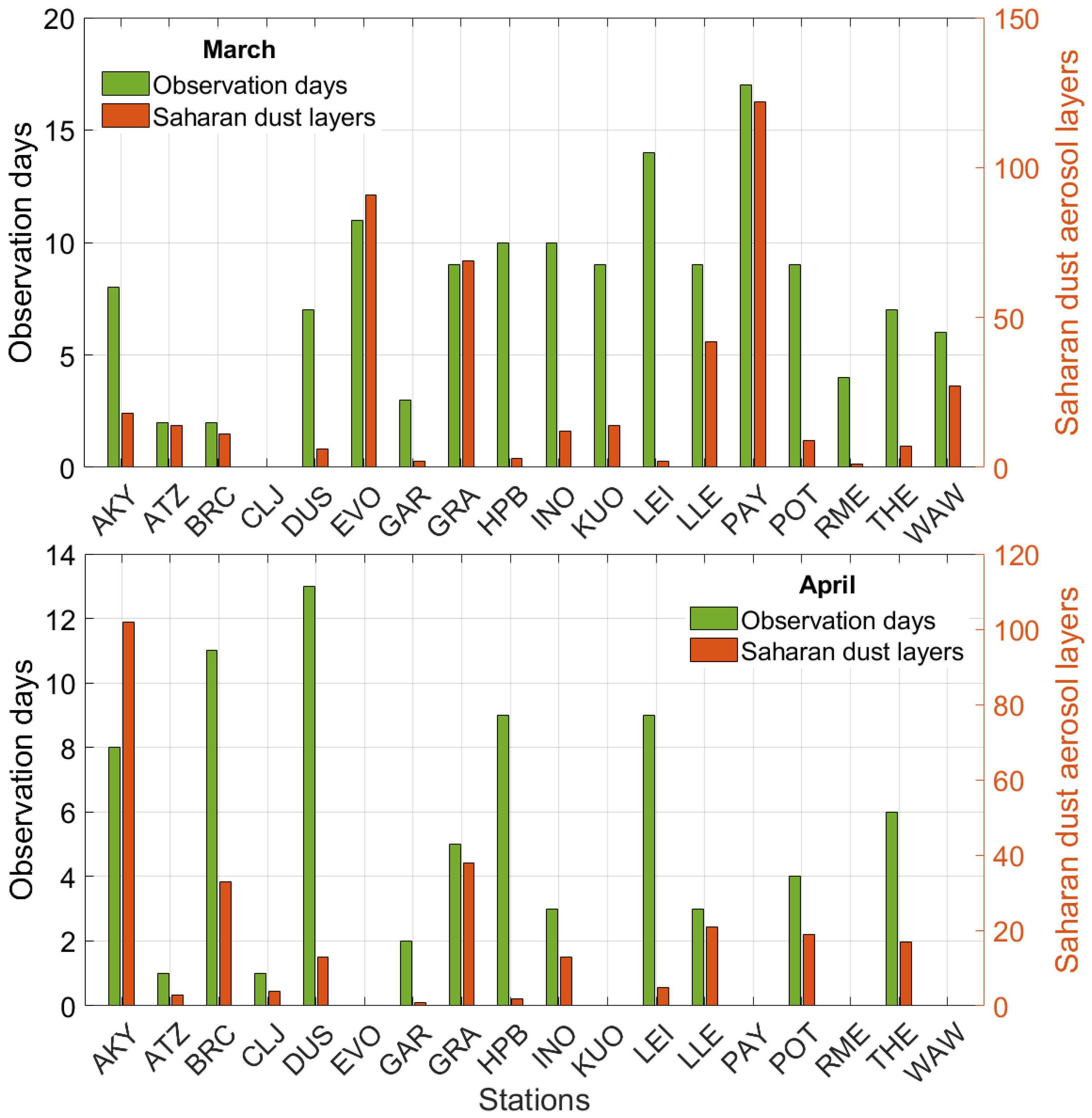


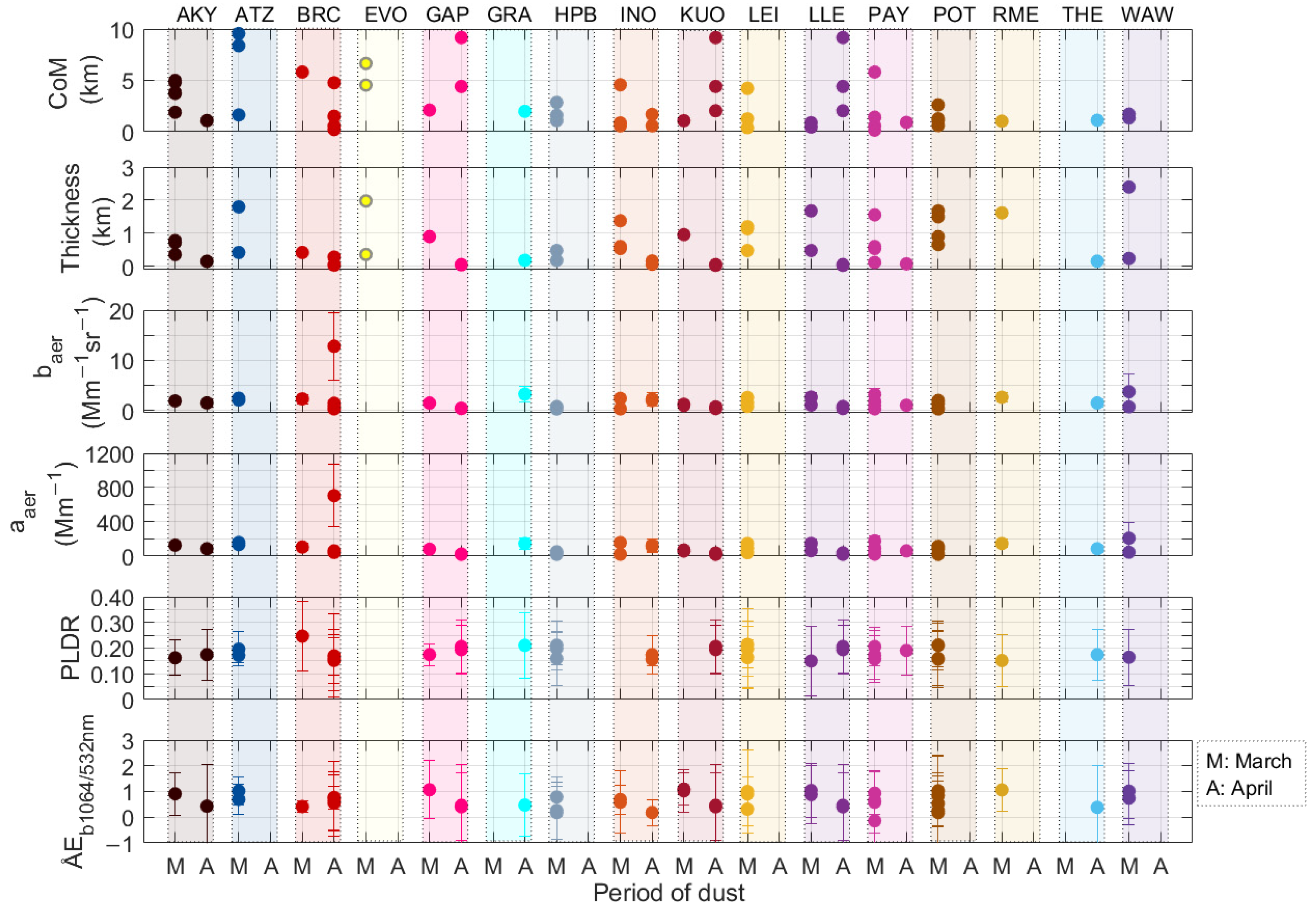
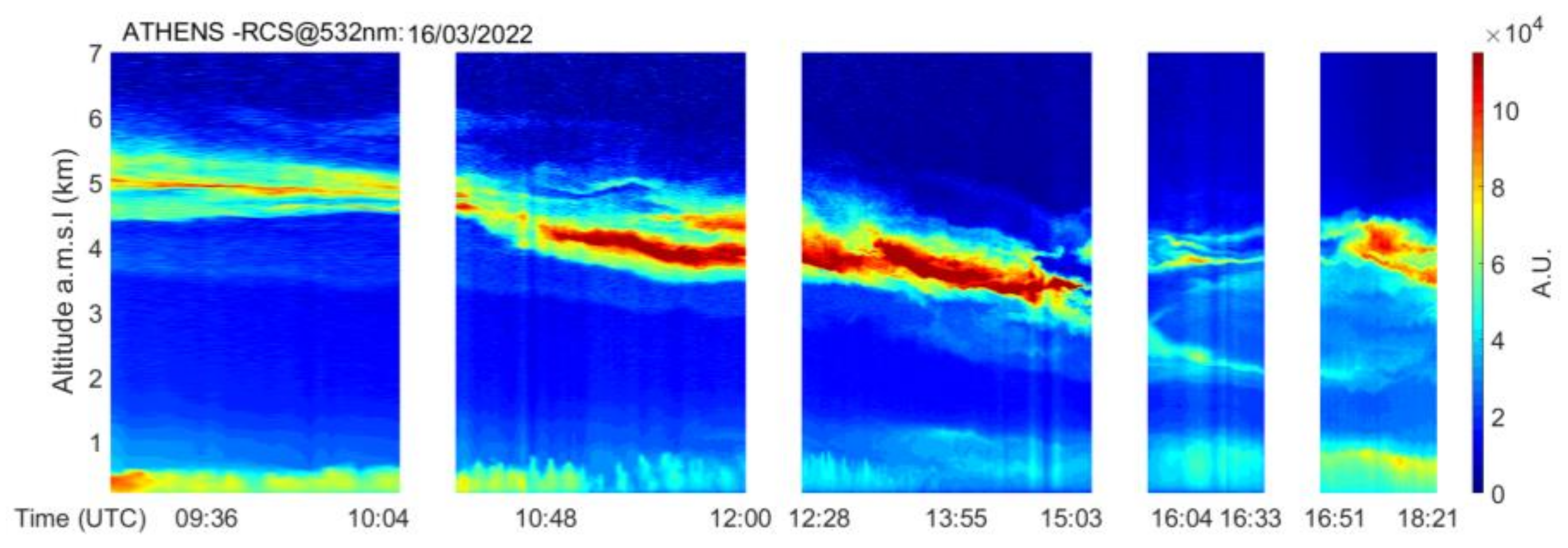
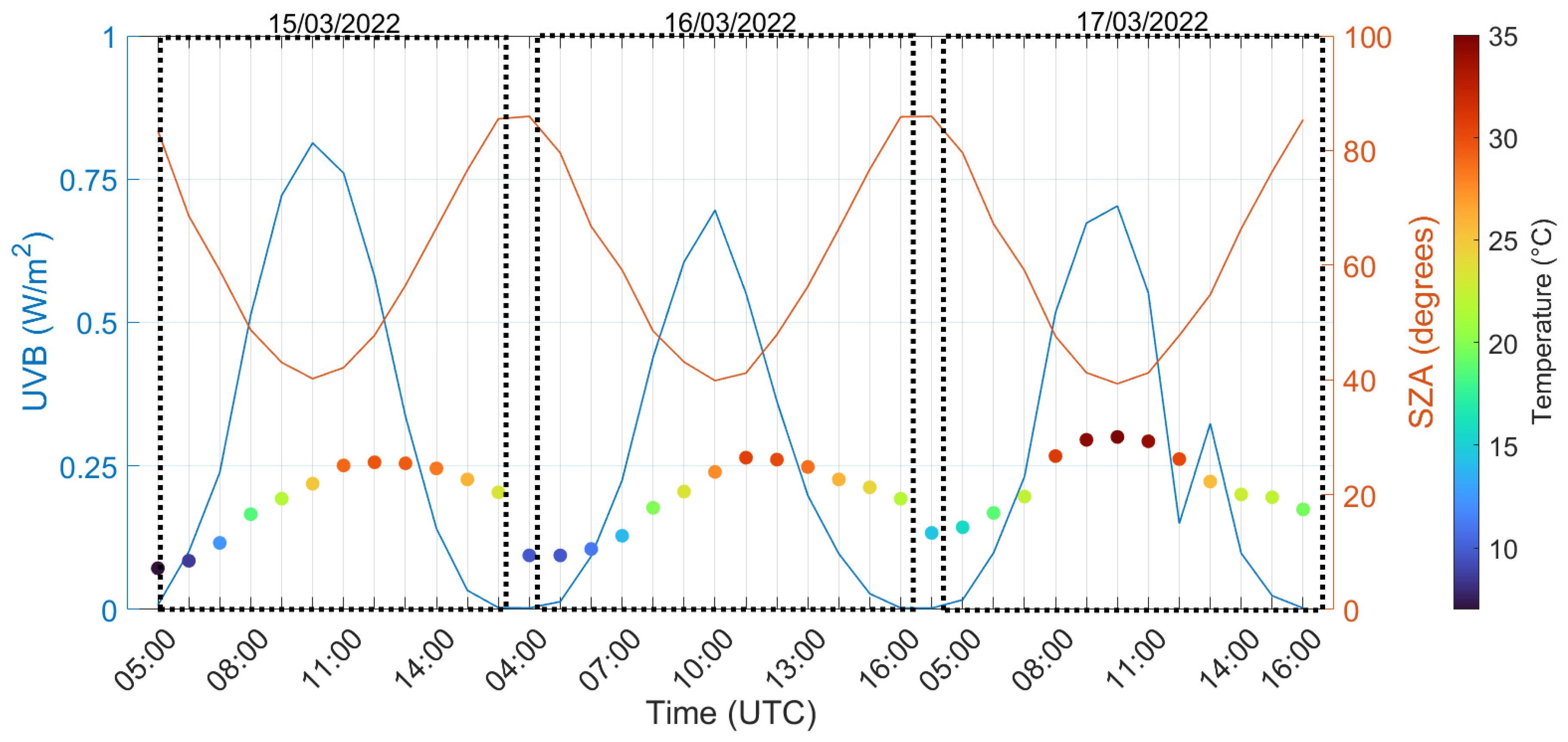
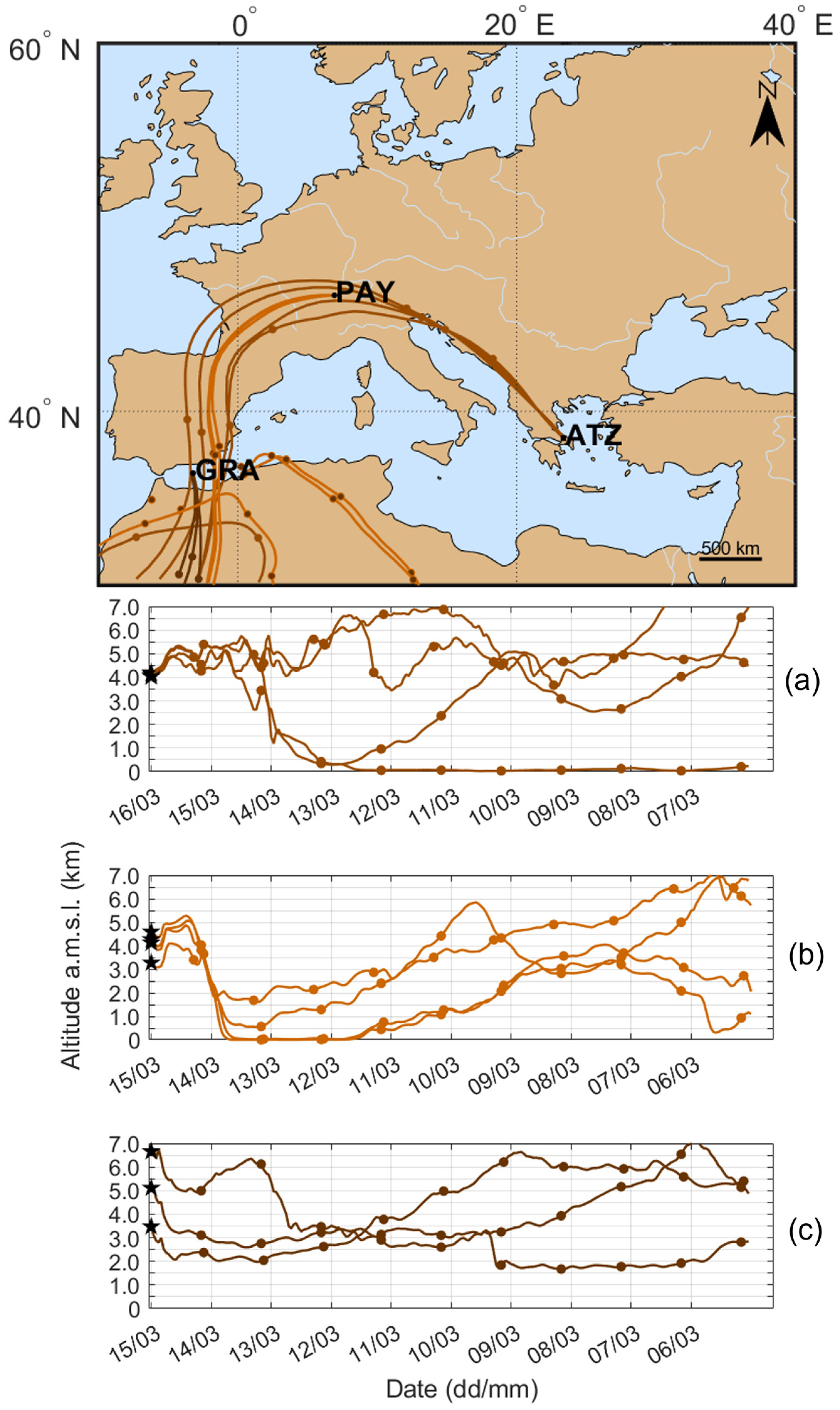
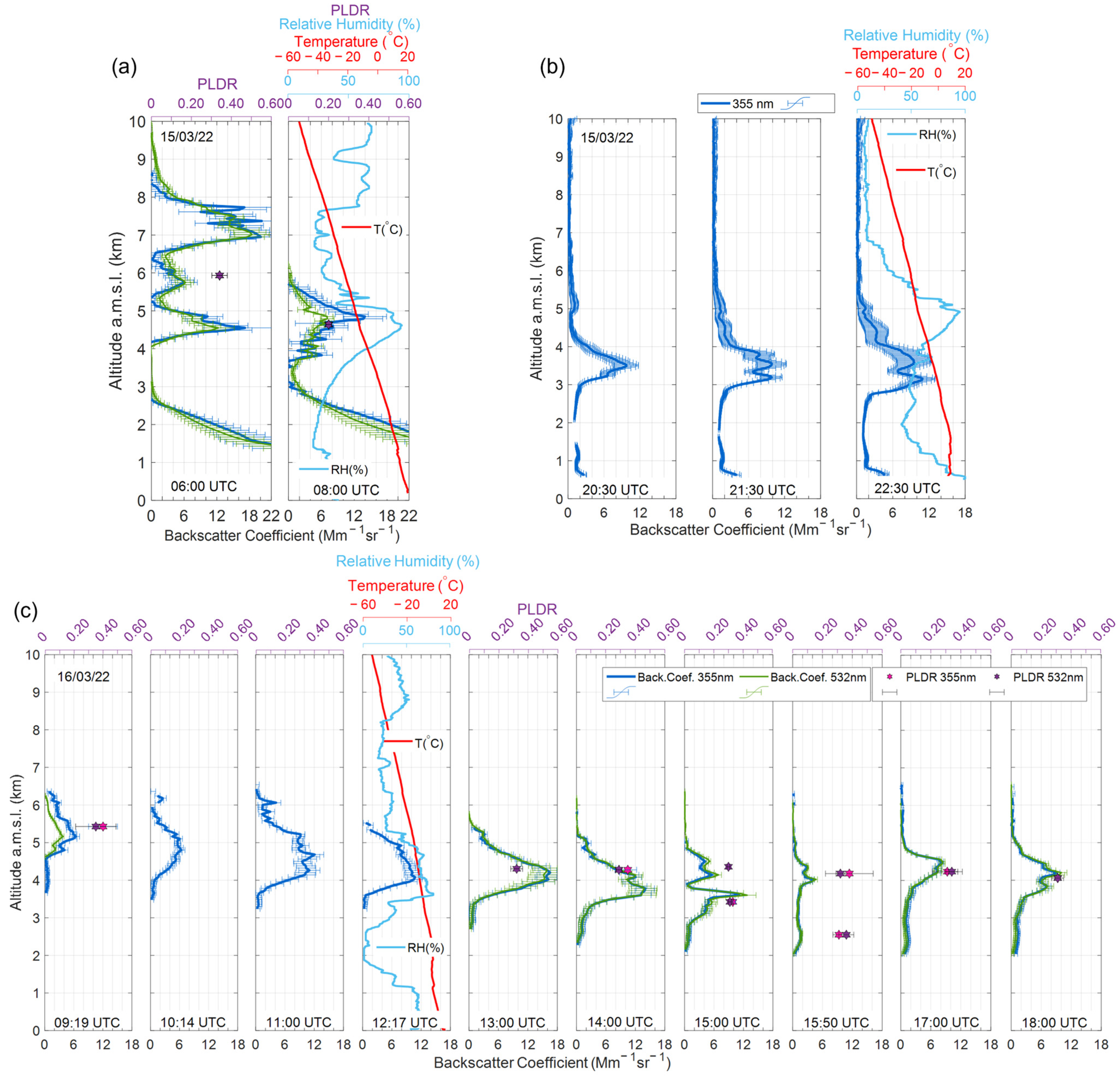
| Location | Institute | Code | Coordinates | Lidar Setup |
|---|---|---|---|
| Antikythera, Greece | National Observatory of Athens-NOA | AKY | 35.8600°N, 23.3100°E, 193 m | 3baer + 2aaer + 2PLDR |
| Athens, Greece | National Technical University of Athens, Physics Department | ATZ | 37.9600°N, 23.7800°E, 212 m | 3baer + 2aaer + 2PLDR |
| Barcelona, Spain | Universitat Politecnica de Catalunya, Barcelona | BRC | 41.3930°N, 2.1200°E, 115 m | 3baer + 2aaer + 2PLDR |
| Bucharest, Romania | National Institute of R&D for Optoelectronics (INOE) | INO | 44.3480°N, 26.0290°E, 93 m | 3baer + 2aaer + 1PLDR(532nm) |
| Cluj-Napoca, Romania | Babes-Bolyai University of Cluj Napoca | CLJ | 46.7682°N, 23.5509°E, 405 m | 3baer + 2aaer + 2PLDR |
| Dushanbe, Tajikistan | Leibniz Institute for Tropospheric Research, Leipzig | DUS | 38.5594°N, 68.8561°E, 864 m | 3baer + 2aaer + 2PLDR |
| Evora, Portugal | Institute for Earth Sciences (ICT-Instituto de Ciencias da Terra) | EVO | 38.5678°N, −7.9115°E, 293 m | 3baer + 2aaer + 1PLDR(532nm) |
| Garmisch-Partenkirchen-Zugspitze, Germany | Karlsruher Institut für Technologie, KIT, Garmisch-Partenkirchen | GAP | 47.4167°N, 10.9797°E, 2675 m | 1baer(532nm) |
| Granada, Spain | Andalusian Institute for Earth System Research, University of Granada (IISTA-CEAMA) | GRA | 37.1640°N, −3.6050°E, 680 m | 3baer + 1PLDR(532nm) |
| Kuopio, Finland | Finnish Meteorological Institute (FMI), Atmospheric Research Centre of Eastern Finland, Kuopio | KUO | 62.7338°N, 27.5431°E, 190 m | 3baer + 2PLDR |
| Leipzig, Germany | Leibniz Institute for Tropospheric Research, Leipzig | LEI | 51.3500°N, 12.4330°E, 125 m | 2baer(1064,532nm) + 2aaer + 2PLDR |
| Lille, France | Lille University-Science and Technology | LLE | 50.6117°N, 3.1417°E, 60 m | 3baer + 2aaer + 2PLDR |
| Observatory Hohenpeißenberg, Germany | DWD Meteorological Observatory Hohenpeissenberg | HPB | 47.8019°N, 11.0119°E, 974 m | 3baer + 2aaer + 1PLDR(532nm) |
| Payerne, Switzerland | MeteoSwiss Aerological Station, Payerne, EPFL, Losanne | PAY | 46.8167°N, 6.9333°E, 491 m | 1baer(355nm) |
| Potenza, Italy | Consiglio Nazionale delle Ricerche-Istituto di Metodologie per l’Analisi Ambientale (CNR-IMAA), Potenza | POT | 40.6000°N, 15.7200°E, 760 m | 3baer + 2aaer + 1PLDR(532nm) |
| Roma-Tor Vergata, Italy | Consiglio Nazionale delle Ricerche-Istituto di Scienze Marine | RME | 41.8330°N, 12.6500°E, 110 m | 1baer(532nm) |
| Thessaloniki, Greece | Aristotle University of Thessaloniki, Thessaloniki | THE | 40.6300°N, 22.9500°E, 50 m | 3baer + 2aaer + 1PLDR(532nm) |
| Warsaw, Poland | University of Warsaw, Faculty of Physics | WAW | 52.2111°N, 20.9835°E, 112 m | 2baer(532,355nm) + 2aaer + 2PLDR |
| March period of dust | Region M-I | Region M-II | Region M-III | Region M-IV |
| AKY, BRC, EVO, GRA, POT | DUS | GAP, HPB, KUO, LEI, LLE, PAY, WAW | ATZ, INO, RME, THE | |
| -South and West Europe -Air mass trajectories directly linked with the Saharan desert | -Station containing Central Asian dust [29] | -Central and northern Europe -Longer air mass trajectories crossing over other areas | -Southern and eastern Europe -Trajectories not directly connected to the Saharan desert -Air masses traveled over other areas before reaching the stations | |
| April period of dust | Region A-I | Region A-II | Region A-III | Region A-IV |
| AKY, ATZ, BRC, GRA, POT | CLJ, DUS | GAP, HPB, LEI, LLE | INO, THE | |
| -Southern Europe -Air mass trajectories directly linked with the Saharan desert | -Station containing Central Asian dust | -Central and northern Europe -Longer air mass trajectories crossing over other areas before reaching the stations | -Southern and eastern Europe -Air masses traveled over other areas before reaching the stations |
| Optical Properties | Region M-I | Region M-II | Region M-III | Region M-IV |
| PLDR 355 nm | 0.25 ± 0.09 | 0.20 | 0.27 ± 0.05 | 0.32 ± 0.06 |
| PLDR 532 nm | 0.27 ± 0.06 | 0.24 ± 0.03 | 0.31 ± 0.05 | 0.26 ± 0.07 |
| LR 355 nm (sr) | 50 ± 3 | 36 | 45 ± 7 | 45 ± 12 |
| LR 532 nm (sr) | 49 ± 6 | 39 | 54 ± 8 | 51 ± 8 |
| ÅEa532/355 | 0.08 ± 0.50 | 0.53 | 0.04 ± 0.38 | 0.25 ± 0.12 |
| ÅEb532/355 | 0.07 ± 0.39 | 0.23 | 0.69 ± 0.25 | −0.03 ± 0.26 |
| ÅEb1064/532 | 0.72 ± 0.17 | 1.01 | 0.75 ± 0.17 | 0.83 ± 0.41 |
| Optical Properties | Region A-I | Region A-II | Region A-III | Region A-IV |
| PLDR 355 nm | 0.29 ± 0.06 | 0.22 | 0.22 | - |
| PLDR 532 nm | 0.31 ± 0.06 | 0.31 ± 0.09 | 0.28 ± 0.04 | 0.25 ± 0.09 |
| LR 355 nm (sr) | 51 ± 4 | - | 48 | 35 |
| LR 532 nm (sr) | 45 ± 10 | - | 48 ± 4 | 46 |
| ÅEa532/355 | −0.30 ± 0.46 | - | 0.34 ± 0.50 | −0.21 |
| ÅEb532/355 | 0.21 ± 0.43 | −0.09 ± 0.16 | 0.59 ± 0.61 | 0.59 |
| ÅEb1064/532 | 0.43 ± 0.48 | 0.95 | 0.51 ± 0.27 | 1.10 ± 0.10 |
Disclaimer/Publisher’s Note: The statements, opinions and data contained in all publications are solely those of the individual author(s) and contributor(s) and not of MDPI and/or the editor(s). MDPI and/or the editor(s) disclaim responsibility for any injury to people or property resulting from any ideas, methods, instructions or products referred to in the content. |
© 2024 by the authors. Licensee MDPI, Basel, Switzerland. This article is an open access article distributed under the terms and conditions of the Creative Commons Attribution (CC BY) license (https://creativecommons.org/licenses/by/4.0/).
Share and Cite
Papanikolaou, C.-A.; Papayannis, A.; Gidarakou, M.; Abdullaev, S.F.; Ajtai, N.; Baars, H.; Balis, D.; Bortoli, D.; Bravo-Aranda, J.A.; Collaud-Coen, M.; et al. Large-Scale Network-Based Observations of a Saharan Dust Event across the European Continent in Spring 2022. Remote Sens. 2024, 16, 3350. https://doi.org/10.3390/rs16173350
Papanikolaou C-A, Papayannis A, Gidarakou M, Abdullaev SF, Ajtai N, Baars H, Balis D, Bortoli D, Bravo-Aranda JA, Collaud-Coen M, et al. Large-Scale Network-Based Observations of a Saharan Dust Event across the European Continent in Spring 2022. Remote Sensing. 2024; 16(17):3350. https://doi.org/10.3390/rs16173350
Chicago/Turabian StylePapanikolaou, Christina-Anna, Alexandros Papayannis, Marilena Gidarakou, Sabur F. Abdullaev, Nicolae Ajtai, Holger Baars, Dimitris Balis, Daniele Bortoli, Juan Antonio Bravo-Aranda, Martine Collaud-Coen, and et al. 2024. "Large-Scale Network-Based Observations of a Saharan Dust Event across the European Continent in Spring 2022" Remote Sensing 16, no. 17: 3350. https://doi.org/10.3390/rs16173350
APA StylePapanikolaou, C.-A., Papayannis, A., Gidarakou, M., Abdullaev, S. F., Ajtai, N., Baars, H., Balis, D., Bortoli, D., Bravo-Aranda, J. A., Collaud-Coen, M., de Rosa, B., Dionisi, D., Eleftheratos, K., Engelmann, R., Floutsi, A. A., Abril-Gago, J., Goloub, P., Giuliano, G., Gumà-Claramunt, P., ... Voudouri, K. A. (2024). Large-Scale Network-Based Observations of a Saharan Dust Event across the European Continent in Spring 2022. Remote Sensing, 16(17), 3350. https://doi.org/10.3390/rs16173350















